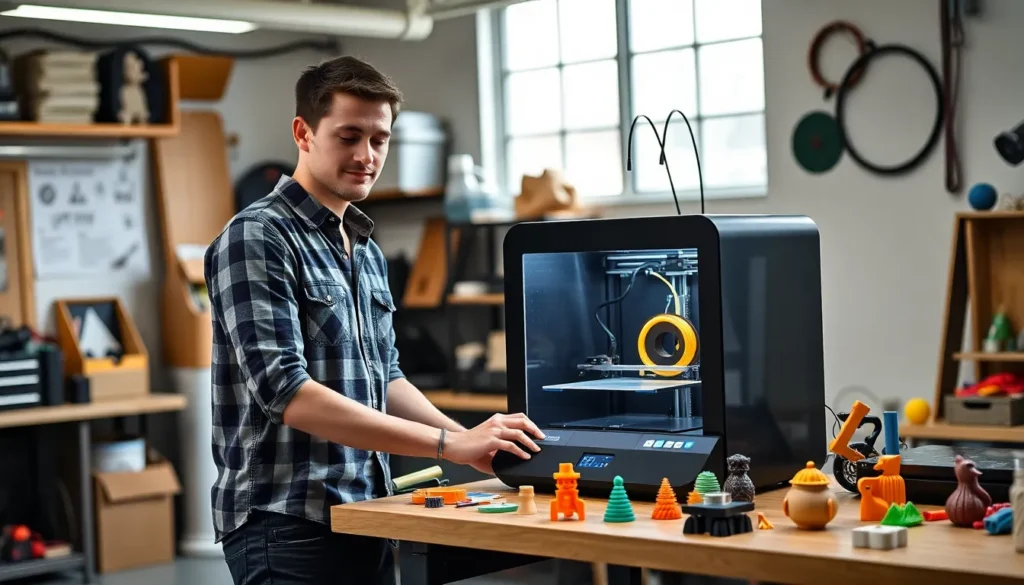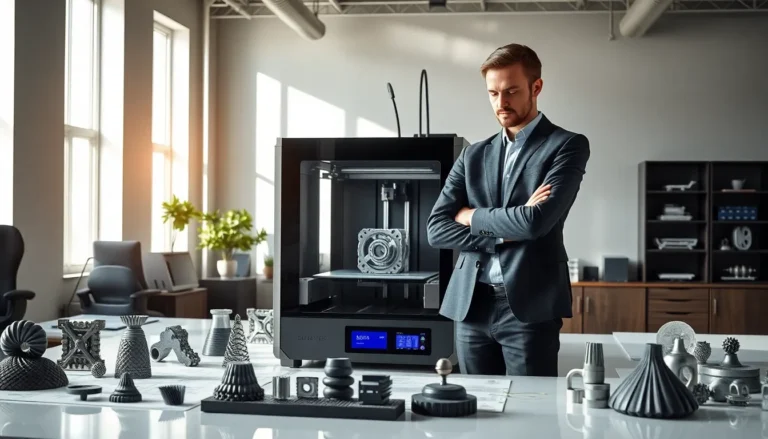Table of Contents
ToggleIn a world where creativity knows no bounds, consumer 3D printers are the magic wands everyone’s been waiting for. Imagine turning your wildest ideas into tangible objects faster than you can say “where’s my coffee?” These nifty devices are not just for techies anymore; they’re for anyone with a spark of imagination and a desire to DIY their way through life.
Overview of Consumer 3D Printers
Consumer 3D printers provide an innovative way for individuals to transform digital designs into tangible products. These machines cater to various skill levels, making them suitable for hobbyists, educators, and small businesses alike. Companies like Creality and Prusa Research lead the market, offering affordable and reliable models.
Different printing technologies, including Fused Deposition Modeling (FDM) and Stereolithography (SLA), enable diverse applications. FDM printers use thermoplastic filaments, while SLA printers utilize resin to create detailed objects. Each method has its benefits, with FDM being popular for ease of use and material availability.
Print quality and speed vary among models. Consumer printers can achieve layer resolutions as fine as 50 microns, providing smooth finishes for intricate designs. Typical print speeds range from 30 to 150 millimeters per second, depending on the complexity of the project.
User-friendly features enhance accessibility. Touchscreens, automatic bed leveling, and app connectivity simplify the 3D printing experience. Filament sensors and power recovery options further minimize interruptions during the printing process.
Materials used in consumer 3D printing are growing in diversity. Thermoplastics like PLA, ABS, and PETG remain popular options. Furthermore, biodegradable and specialty filaments cater to eco-conscious users and specific project needs.
Supportive online communities and resources make learning and troubleshooting easier. Enthusiasts share tips, designs, and modifications through forums and social media. Access to design software and downloadable templates allows users to kickstart their projects quickly.
Key Features of Consumer 3D Printers

Consumer 3D printers offer various features that enhance usability and output quality. Understanding these key aspects helps users maximize their 3D printing experiences.
Print Quality
Print quality varies significantly among consumer 3D printers. Resolution, measured in microns, determines the detail level in printed objects. Models may reach resolutions as fine as 20 microns, allowing for intricate designs. Layer adhesion also affects durability and aesthetics. Users benefit from optimizing print speed and temperature settings, which influence the final output. Comparing different machines reveals differences in nozzle size and filament flow control, impacting print quality.
Build Volume
Build volume plays an essential role in project capabilities. Common consumer printer sizes range from 120mm x 120mm x 120mm to larger models over 300mm x 300mm x 300mm. Larger build volumes enable users to create bigger objects or multiple smaller projects in one print. It’s essential to consider how build volume aligns with intended projects. Opting for a model that suits specific needs ensures efficient use of time and resources.
Material Compatibility
Material compatibility enhances project versatility. Popular thermoplastics like PLA and ABS cater to different applications, offering varying strength and finish qualities. Advanced prints may utilize flexible filaments or composites for added functionality. Eco-friendly options like biodegradable materials appeal to environmentally conscious users. Users often discover that exploring different materials broadens their creative possibilities. Compatibility with various filaments allows for experimentation and customization across projects.
Popular Consumer 3D Printers on the Market
Several consumer 3D printers stand out for their impressive features and user-friendly designs. These models cater to a wide range of needs, from beginners to experienced users.
Printer A
Creality Ender 3 remains a favorite among hobbyists due to its affordability and solid performance. This FDM printer offers a build volume of 220x220x250mm, making it suitable for various projects. Users appreciate its easy assembly process and wide community support, which provides access to modifications and upgrades. Printing at a resolution of 100 microns, this machine produces detailed models. Its compatibility with multiple filament types allows flexibility, enhancing creative possibilities.
Printer B
Prusa i3 MK3S is known for its reliability and high-quality output, particularly among advanced users. Featuring a build volume of 250x210x210mm, this printer excels in producing intricate designs. Automatic bed leveling and power recovery features add convenience, making it user-friendly. With a layer resolution down to 50 microns, it achieves exceptional detail. Moreover, the printer supports a variety of materials, including PLA, PETG, and ABS, providing versatility for different applications.
Printer C
Anycubic Photon Mono offers an excellent entry point for those interested in resin printing. Its compact build volume of 130x80x165mm is ideal for detailed miniature models and intricate prints. Printing with a resolution of 50 microns, it captures fine details with ease. The monochrome LCD screen speeds up prints, reducing curing time, while the intuitive interface simplifies operation. Compatibility with various resin types allows users to experiment with colors and finishes, making it a popular choice among creators.
Advantages of Using a Consumer 3D Printer
Consumer 3D printers offer numerous benefits for both novice and experienced users. Accessibility ranks high among these advantages, allowing individuals from various backgrounds to create objects effortlessly. Customization options expand significantly, enabling users to design unique products tailored to their specific needs.
Cost-effectiveness attracts many hobbyists and small businesses. Reduced manufacturing costs compared to traditional methods support budget-friendly production. Prototyping becomes a more straightforward process, allowing rapid testing and iteration of design concepts without large investments.
Flexibility in materials further enhances the appeal. Users can choose from a wide range of thermoplastics and eco-friendly options, making it easier to experiment with different project requirements. Printing multiple items concurrently optimizes resources and time efficiency, catering to diverse creative projects.
User-friendliness proves essential for broader adoption. Intuitive interfaces, touchscreens, and automatic bed leveling simplify the printing experience for beginners. Online communities foster support, providing valuable resources for troubleshooting, design sharing, and best practices.
Time savings also play a crucial role. Fast print speeds allow users to produce items quickly, significantly reducing waiting periods. Custom projects, whether for artistic expression or functional solutions, come to life rapidly.
Educational uses represent another significant advantage. Students and educators harness 3D printers to teach concepts related to design, engineering, and problem-solving. Hands-on learning experiences enhance comprehension and creativity, making lessons more engaging.
Sustainability considerations shape the future of consumer 3D printing. Eco-friendly materials and reduced waste during production contribute to a more sustainable approach. Adopting these practices aligns with growing environmental consciousness in various industries.
Considerations Before Buying a Consumer 3D Printer
Budget plays a significant role when selecting a consumer 3D printer. Prices range from under $200 to over $1,500, depending on specifications and features. Determine the intended use to narrow down suitable options.
Print quality is another critical factor. Consumers must assess layer resolution, which can vary from 50 to 400 microns, impacting the final product’s smoothness and detail. Look for printers that provide high-quality output for intricate designs.
Build volume also influences decisions. Common sizes range from 120mm to over 300mm and directly correlate with the scale of potential projects. Ensure the chosen printer accommodates the dimensions required for the planned creations.
Material compatibility is essential for diverse project needs. Many consumer 3D printers support various filaments like PLA, ABS, and PETG. Users should choose printers that allow experimentation with different materials, expanding creativity.
Ease of use enhances overall satisfaction. Features like touchscreen interfaces and automatic bed leveling simplify operation, especially for beginners. Higher-end printers often come equipped with advanced connectivity options, making it easier to integrate designs via apps.
Community support is invaluable for novice users. Engaging with online forums and groups provides access to troubleshooting tips, design software, and templates. A supportive community can significantly enhance the learning experience.
Finally, consider long-term goals and potential upgrades. Some models allow enhancements, which can extend their usability. Investing in a printer with a solid upgrade path ensures it remains relevant as technology evolves.
Consumer 3D printers have opened up a world of possibilities for creative expression and innovation. With their user-friendly features and diverse material options, these printers cater to everyone from hobbyists to educators and small business owners. The growing accessibility and affordability of models from brands like Creality and Prusa Research make it easier than ever to dive into the world of 3D printing.
As technology continues to evolve, the potential for customization and sustainability in 3D printing will only expand. Engaging with supportive online communities can enhance the user experience and foster a culture of sharing and learning. Embracing this technology allows individuals to transform their ideas into reality while contributing to a more sustainable future.




